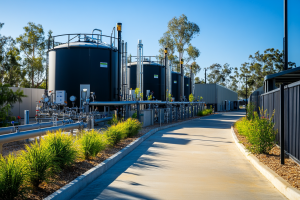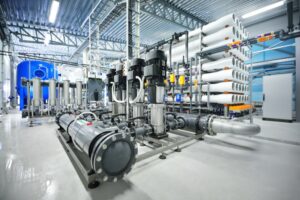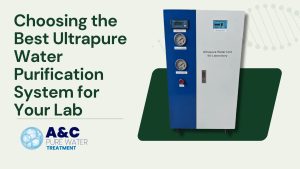Work flow of softening water equipment
Work (sometimes called water production, the same below), backwash, salt absorption (regeneration), slow washing (replacement), quick washing five processes. All the processes of different softening water equipment are very similar, but there may be some additional processes due to the difference of actual process or control needs. Any sodium-exchange-based water softener is developed on the basis of these five processes (automatic water softeners add brine reinjection).
Backwashing: after a period of work, the equipment will intercept a lot of dirt brought by raw water in the upper part of the resin. After the removal of these dirt, the ion exchange resin can be fully exposed and the effect of regeneration can be guaranteed. The backwash process involves water washing in from the bottom of the resin and out from the top, which washes away the dirt trapped at the top. This process usually takes about 5-15 minutes.
Salt absorption (regeneration) : the process of injecting salt water into resin tank. The traditional equipment is to inject salt water with a salt pump. The fully automatic equipment is to inhale salt water with a special built-in ejector (as long as there is a certain pressure in the water). In the actual working process, the regeneration effect of salt water flowing through resin at a slower speed is better than that of soaking resin in salt water alone, so the softening water equipment is using the method of regeneration of salt water flowing through resin at a slower speed. This process generally takes about 30 minutes, and the actual time is affected by the amount of salt.
Slow flushing (displacement) : after through the resin with brine, will slowly with the raw water with the same velocity of resin rinse clean all the salt washing process is slower, because this flushing process there are still a lot of calcium and magnesium ions on the functional groups by sodium ion exchange, according to the practical experience, the process is the main process of regeneration, so a lot of people will this process is called substitution. This process is generally the same as salt absorption time, that is, about 30 minutes.
Quick rinse: In order to rinse the residual salt thoroughly, the resin should be rinsed with raw water at a flow rate close to the actual work. The final effluent from this process should be soft water to the standard. Generally, the quick rinse process takes 5 to 15 minutes.
Technical indicators and working requirements of softening water equipment:
Inlet water pressure: 0.18-0.6mpa
Working temperature: 1-55℃ Source water hardness: <8mmol/L
Operation mode: automatic/manual outlet water hardness: ≤0.03mmol/L
Regenerating agent: NaCL Regeneration mode: downstream/countercurrent
Exchange agent: 001*7 strong acid ion exchange resin
Control mode: time/flow Power supply: 220V/50Hz
The role of soft water treatment
1. The use of water softening equipment saves a lot of wasted fuel
When there is scale in the boiler, 1mm scale will be generated in the boiler with working pressure of 1.4mpa, and 8% fuel will be wasted.
2.Soften water equipment to improve thermal efficiency and reduce output
When there is scale on the evaporation surface of the boiler, the heat of the fire side can not be transferred quickly to the feed side will reduce the output of the boiler. If because of improper water treatment, boiler scaling, boiler evaporation capacity is reduced by one-third, because of insufficient gas supply automatic operation line can not start.
3.Use of softening water equipment to reduce boiler maintenance
Boiler plate or pipe with scale, it is very difficult to remove, especially because of scale caused by boiler leakage, cracks, damage, deformation, corrosion and other diseases. Not only damage the boiler, but also consume a lot of manpower and material resources to repair, not only shorten the operation time, but also increase the maintenance cost.
4.The application of softening water equipment to reduce safety threats
Boiler scale accidents, accounting for more than 20% of boiler accidents, not only resulting in equipment loss, but also a threat to personal safety. Infrastructure and operating costs for water treatment account for a quarter of the savings.







